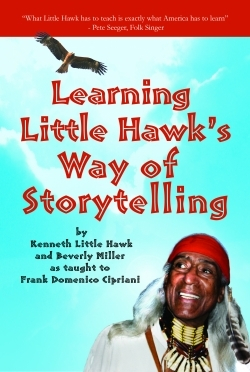Learn Little Hawk’s Way of Storytelling
A drum suddenly sounds, startling the young, rowdy listeners. A hush descends as a man in traditional First Nation garb proceeds to the front of the group. Immediately and almost magically, he captures the full attention of each child, bringing laughter and learning, reaching their hearts. This is Kenneth Little Hawk, a renowned, traditional oral storyteller, and he shares the secrets to his craft in Learn Little Hawk’s Way of Storytelling.
Through captivating tales, Little Hawk reveals centuries of techniques carefully passed down through native cultures from storyteller to storyteller. Readers join a main character, Many Smiles, from his boyhood when he dreamed of becoming a storyteller through his youth learning basic techniques to his adulthood when he polishes his craft. As readers follow the story of how Little Hawk learned to be a storyteller, they grow with him, but through example rather than straightforward explanation.
Little Hawk divides his book into five parts, each covering a stage in Many Smiles’s growth as a human being and storyteller. Each section includes chapters focused on a specific technique for learning to tell stories. Lessons teach everything from developing a playful spirit; using sounds, voices, and visual aids; keeping the audience’s attention and focus; developing formal plot structure; weaving in truth; and ensuring stories reach the heart.
The book is captivating and entertaining with a warm, inviting tone. It reads like a fascinating collection of stories rather than a didactic “how-to.” And perhaps the best way, the only way, to learn storytelling is to see it in practice, which this approach encourages.
This book sparks the inner storyteller in everyone, causing readers to long for a group of children, or even adults, on whom they can try their hand. It should be read by anyone who works with or loves children, whether a parent, teacher, librarian, or children’s program leader. Ultimately, it’s for anyone who loves telling a good story. It’s important to note that the narrative is highly focused on oral storytelling. And, although a curriculum is provided at the end, the book may challenge those for whom a black-and-white method of learning is essential. But for the vast majority of readers, it’s simply an inspiring read, challenging us to find and tell stories of our own.
Reviewed by
Diane Gardner
Disclosure: This article is not an endorsement, but a review. The publisher of this book provided free copies of the book to have their book reviewed by a professional reviewer. No fee was paid by the publisher for this review. Foreword Reviews only recommends books that we love. Foreword Magazine, Inc. is disclosing this in accordance with the Federal Trade Commission’s 16 CFR, Part 255.

